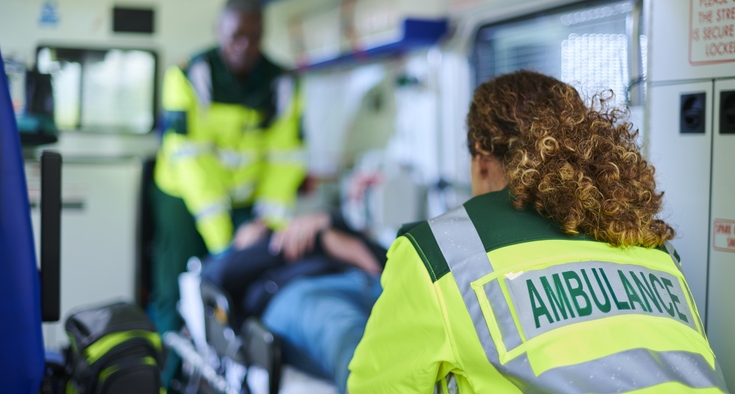Many people assume that a heart attack and cardiac arrest are the same thing, but they’re not. And in fact, cardiac arrest can be far deadlier. Here to explain more is cardiologist Dr. Kaustubh Dabhadkar.
What is cardiac arrest?
Cardiac arrest happens when the heart suddenly stops pumping blood, causing blood to stop flowing to the rest of the body. It’s also called “sudden cardiac arrest” because it usually happens without warning.
Every day, more than 1,000 people in the U.S. experience cardiac arrest, most outside of a hospital setting. The majority die before they get to the hospital.
However, it’s possible to survive cardiac arrest with the right care — and the right response from bystanders can double or even triple the chances of survival. Read on for more.
Access nationally recognized heart care
What does cardiac arrest look like?
It usually happens out of nowhere: A person will suddenly collapse, become unresponsive and stop breathing normally. Their heart “arrests,” or stops beating. You won’t feel their pulse.
This is in contrast to a heart attack, where a person can generally communicate that they’re having symptoms like chest pain or pressure, shortness of breath, or are feeling dizzy or nauseous. Someone having a heart attack most often does not lose consciousness; if they do, it is brief. Either situation is an emergency.
Why does cardiac arrest happen?
When our heart works correctly, it pumps blood to our lungs, brain, and the rest of our organs so they can do their job.
But sometimes our heart stops pumping blood. It might stop beating completely, or it might start quivering ineffectively. This is called cardiac arrest, and it means blood can stop flowing to the lungs, brain and rest of the organs. This is an emergency. It’s not the same thing as a heart attack. (See below.)
The most common reason cardiac arrest happens is a heart attack, which is a lack of blood supply to a part of the heart. But cardiac arrest could also happen in other situations, like a large blood clot within the lungs or quivering of the heart because a patient is experiencing a heart syndrome called an “electrical storm.”
What kind of medical treatment is needed?
If you see someone in cardiac arrest, call 911 immediately, put the call on speakerphone, and use the following techniques while you wait for first responders to arrive:
• Cardiopulmonary resuscitation (CPR): If you provide CPR to a person immediately after they go into cardiac arrest, you can double or even triple their chances of survival. CPR keeps the blood moving through their body, preventing organ and brain damage. Ideally, you will perform CPR as a stopgap measure until a defibrillator is available.
• Defibrillator/automated external defibrillator (AED): A person in cardiac arrest needs their heart rhythm reset. First responders use a defibrillator: a tool that gives an electrical shock to the heart to get it beating on an effective rhythm again.
The odds of survival go down 10% for every minute that defibrillation is delayed. That’s why a lot of public places have an automated external defibrillator (AED), which any of us can use even if we aren’t medically trained. An AED analyzes the heart’s rhythm and delivers an electrical shock if it’s needed, giving step-by-step instructions out loud.
If someone’s in cardiac arrest and there’s an AED within reach, call 911, grab the AED as you make the call, and begin using it. If there isn’t an AED nearby and you’re the only person available, just focus on calling 911 and performing CPR. If there are there are several people around to respond, have one perform CPR while the other calls 911 and looks for an automated external defibrillator (AED) nearby.
Once a person makes it to the hospital, care teams will do testing to figure out why they went into cardiac arrest. Treatments can include medication, surgery or implantable devices depending on the cause.
Is cardiac arrest the same thing as a heart attack?
No. Heart attack is the sudden lack of blood supply to the heart. Some heart attacks could cause cardiac arrest, but most don't result in a cardiac arrest.
Cardiac arrest can also occur in other situations like choking, where there is a lack of oxygen supply to the heart muscle.
Are there any warning signs to watch for?
In most cases, there are no warning signs.
However, some people may have symptoms related to one of the underlying causes. For example, a person having a heart attack may have sudden chest discomfort, sudden unexplained profuse sweating and other symptoms of a heart attack. Without intervention, they could have a heart attack and then could go on to experience cardiac arrest.
Other symptoms that might occur before cardiac arrest include heart palpitations (which could feel like fluttering, pounding or very quick heartbeats), dizziness, weakness or shortness of breath.
Is there a way to prevent cardiac arrest?
Unfortunately, a large portion of these events occur in patients who appear healthy before they suddenly collapse. However, the process that leads to the event usually begins years before the event.
Your doctor or primary care provider can identify factors that put you at higher risk for cardiac arrest and give you a personalized plan to help you lower your risks.
In general, keep your heart healthy by exercising regularly, eating a healthy diet, cutting out alcohol and tobacco, and dealing with stress. Managing your blood pressure and cholesterol also goes a long way.
Some people are at higher risk for cardiac arrest because of existing heart conditions, including coronary artery disease, heart valve disease, cardiomyopathy (an enlarged heart), arrhythmia, congenital heart defects, heart failure, infections and rarer heart conditions.
For people who are at a high risk of cardiac arrest because their heart has known electrical instability, doctors can implant a device called a defibrillator. There are also wearable defibrillators which can be worn as a vest. If you’re at a higher risk for cardiac arrest, you can purchase your own AED to keep with you.
You don’t have to be afraid of cardiac arrest: Instead, be prepared. Identify and manage your risks. Learn CPR and pay attention to where AED devices are in the places you go most often. And be ready to help if you see someone suddenly collapse.











